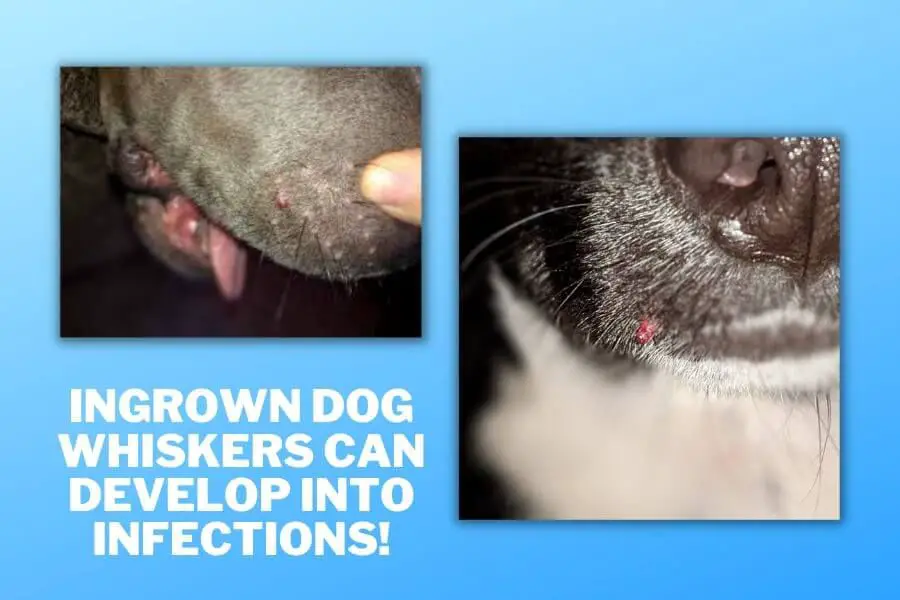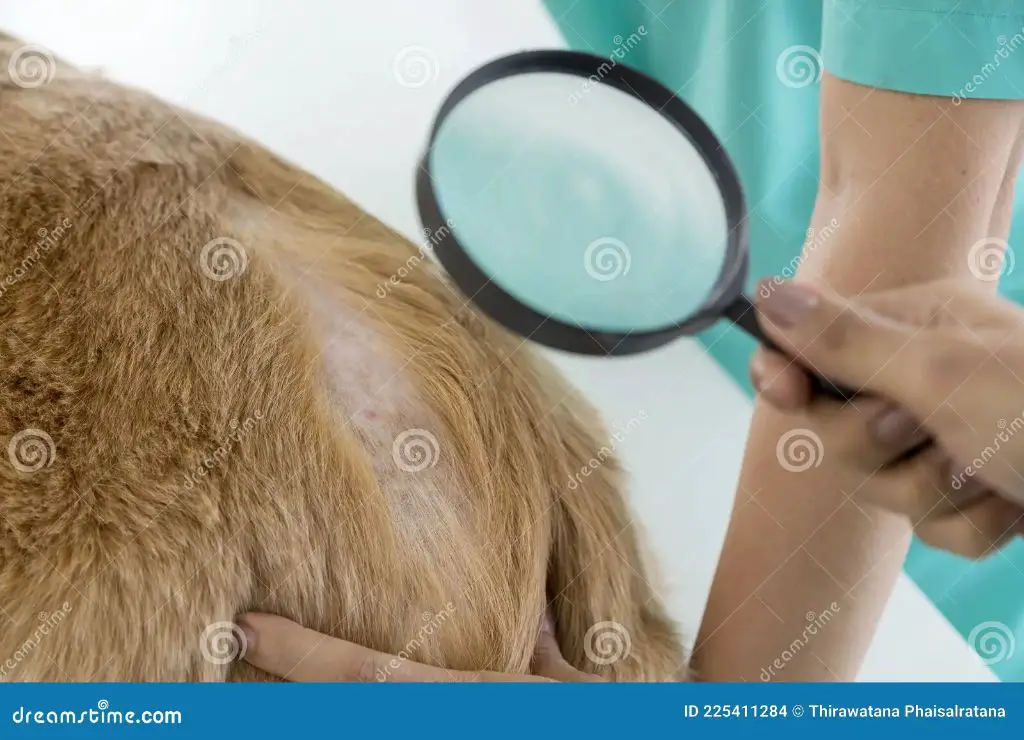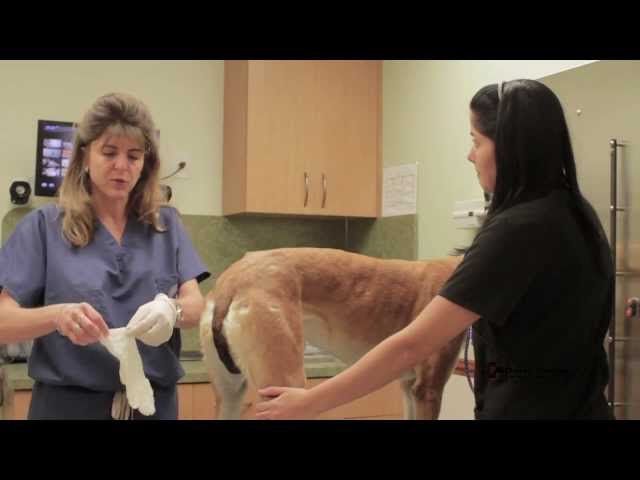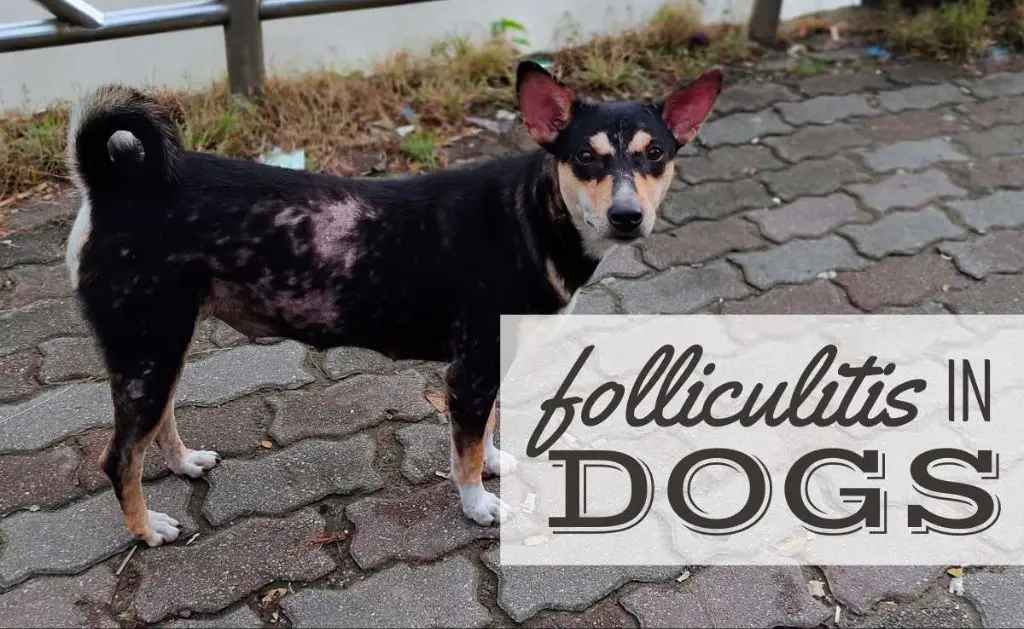What are ingrown whiskers in dogs?
An ingrown whisker is when a dog’s whisker grows back into the follicle or skin instead of growing outward in its normal direction. This causes the whisker to become trapped underneath the skin, leading to irritation and inflammation (Source).
Ingrown whiskers look like small red bumps or raised welts on a dog’s muzzle where their whiskers grow. They may be swollen, itchy, and painful. As the whisker continues to grow inside the follicle, it can cause a bump or lesion to form (Source).

Ingrown whiskers form when a whisker falls out but the new growing whisker gets curled or bent instead of growing straight outward. Things like trauma, skin infections, or obstruction of the follicle can cause the whisker to grow abnormally back into the skin (Source).
What causes ingrown whiskers in dogs?
There are a few potential causes of ingrown whiskers in dogs:
Genetics – Certain breeds like Schnauzers and terriers are more prone to ingrown whiskers due to their wiry coats and follicle shape. The follicles may curve back into the skin instead of growing straight outward.
Damage to the hair follicle – Injuries, infections, or irritation in the area can cause swelling around the hair follicle, preventing the hair from emerging properly. This allows it to turn back into the skin and become ingrown [1].
Improper grooming techniques – Cutting the hair too short or shaving too close to the skin can increase the chances of hairs growing inward. The sharp cut leaves hair ends that are blunt instead of tapered, making them more likely to turn into the skin and embed there [2].
Common locations for ingrown whiskers
Some common locations for ingrown whiskers in dogs include:
- Muzzle – The muzzle, or the area around the nose and mouth, is a very common location for ingrown whiskers in dogs. This area has a dense concentration of stiff whiskers that can potentially grow back inward.
- Under the chin – The skin under the chin is another prime spot for ingrown whiskers. Dogs have sensitive skin in this region that is prone to irritation when a whisker grows sideways instead of outward.
- Eyebrows – The eyebrows above the eyes are populated with short whiskers that can become ingrown. Ingrown eyebrows whiskers may cause discomfort, infection, and swelling around the eyes.
Other less common areas for ingrown whiskers include the sides of the snout, cheeks, legs, and paws.
Ingrown whiskers are most frequently observed on the muzzle, under the chin, and in the eyebrows where whisker density is high.
Signs and symptoms
The most common signs and symptoms of ingrown whiskers in dogs include:
Redness – The skin surrounding an ingrown whisker often appears red and inflamed. This is a reaction to the irritation caused by the embedded hair.
Swelling – There may be swelling around the affected follicle and hair as fluids and pus accumulate. The swollen bump may protrude slightly.
Pus – Pus is made up of dead cells, protein and bacteria. It often oozes from the irritated follicle when the whisker is ingrown. The bump may be filled with pus.
Pain/discomfort – Ingrown hairs cause localized pain and itchiness. Dogs may excessively lick, scratch or rub the area trying to relieve irritation. Pain may worsen when the area is touched.
Risk factors
Certain breeds of dogs are more prone to developing ingrown whiskers due to their coat type and follicle structure. Short-haired breeds like Boxers, Boston Terriers, Greyhounds, and Pit Bulls tend to be more susceptible. The short, coarse hairs of these breeds can curl back into the skin more easily. Additionally, dogs with curly or wire coats like Poodles and terriers may also be predisposed.

Frequent and close clipping or shaving of a dog’s coat increases ingrown whisker risk. When the hairs are trimmed very short, the sharpened tips can poke back into the follicle opening or adjacent skin. Excessive grooming removes the hair’s natural protective oils and alters the normal growth cycle. This disruption often leads to hairs growing sideways or backward instead of upward.
According to https://emergencyvetsusa.com/can-dogs-get-ingrown-whiskers/, short-haired dogs that receive frequent clipping are at the highest risk of developing ingrown whiskers and related infections.
Diagnosis
Veterinarians will diagnose ingrown whiskers in dogs through a physical examination and by analyzing the dog’s medical history for any previous skin issues. The vet will closely inspect the irritated area, looking for signs of infection such as redness, swelling, oozing, and pain. They will check for foreign material lodged around the whisker and gently pluck out any accessible ingrown hairs.
If the cause of the irritation is still unclear after a physical exam, the vet may collect a skin scraping or skin biopsy of the affected area. Skin scrapings allow the vet to look at skin cells under a microscope for signs of infection or inflammation. A biopsy removes a small piece of skin for closer examination and may be sent to a lab for culturing to identify any underlying infections. These diagnostic tests help the vet determine the best treatment approach.
Treatment
The treatment for ingrown whiskers in dogs focuses on removing the embedded hair and controlling any infection or inflammation. There are several approaches vets may use:
Plucking the ingrown hair: The vet may use sterile tweezers to carefully pluck out the ingrown whisker. This helps relieve irritation and prevent further embedding. It’s important not to pluck hairs at home, as this can damage the follicle if not done properly.
Topical antibiotics/steroids: To treat infection and inflammation, the vet may prescribe topical creams containing antibiotics, antifungals, and/or steroids. These are applied to the affected area to control bacterial overgrowth and reduce swelling. Examples include mupirocin, chlorhexidine, and hydrocortisone creams.
Surgery for severe cases: In rare instances, deep cysts or wounds caused by ingrown hairs may require minor surgery to remove embedded hairs and infected tissue. This is only done for severe or recurrent cases that do not respond to more conservative treatments.
In most cases, a combination approach of plucking, topical medications, and keeping the area clean resolves the problem. Preventing recurrences through grooming and skin health is also important.
Home care
There are some home remedies and self-care tips that can help relieve symptoms and potentially allow an ingrown whisker to emerge properly:

- Apply a warm compress to the affected area for 10-15 minutes 2-3 times per day. The warmth can help soften the skin and allow the embedded whisker to emerge. Be sure to use a clean washcloth each time. [1]
- Gently exfoliate the area no more than once or twice a week using a wet washcloth, loofah, or exfoliating scrub. This removes dead skin cells and debris to allow the whisker to break through. Do not scrub too hard or irritate the skin. [2]
- Avoid excessive brushing, combing, clipping or other grooming that could further embed the whisker. Let the area rest and allow the whisker to naturally emerge over time.
With proper home care and observation, many mild ingrown whisker cases can resolve on their own. However, if symptoms persist or worsen, veterinary treatment may be required.
Prevention
Proper grooming techniques can help prevent ingrown whiskers in dogs. When trimming your dog’s face, use rounded tip scissors and avoid cutting whiskers too short. Allowing whiskers to grow out to their natural length will also help prevent ingrowths. Gently brushing around the muzzle daily with a soft bristle brush can help whiskers grow in the proper direction. Avoid plucking whiskers, as the new ones growing in may curve and become ingrown. Some sources recommend applying a light moisturizer or coconut oil to the muzzle area after brushing to soften the follicles and allow whiskers to emerge normally.
According to one source, “You can’t really prevent ingrown hairs on dogs, but early detection is the best way to make sure that the condition doesn’t develop into a painful cyst.” Pay close attention after grooming and let your vet know if you see any signs of ingrown whiskers.
When to see a vet
You should take your dog to see a veterinarian if you notice signs of a skin infection developing around the ingrown whisker. Signs may include redness, swelling, oozing, a foul odor, and your dog licking or biting at the area excessively. Infections require prescription antibiotics to clear up.
It’s also a good idea to have your vet examine any ingrown whiskers that do not seem to be improving with home care after several days. The vet can evaluate if the hair needs to be removed or if other treatment is required.

Additionally, if your dog has multiple ingrown whiskers in several areas, it is best to see your vet for an examination. Multiple ingrown hairs could indicate an underlying skin condition that may need specific treatment.